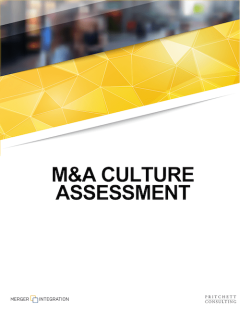
Post-Merger Integration
Consulting Services
Learn More
SHARE THIS PAGE
Register 2 months in advance and save $500.
Listed below are a number of cultural dimensions and indices that are organized across a continuum.
Step 1: Review each cultural characteristic and place an A in the column that most closely represents your perception of the Acquirer’s culture.
Step 2: Place B in the column that most closely represents the Acquired Company’s current culture.
Step 3: Calculate the absolute difference between each rating to determine the largest culture gaps.
| Cultural Characteristics | 1 | 2 | 3 | 4 | 5 | |
|---|---|---|---|---|---|---|
| Strategic Orientation | ||||||
| Customer/Market Driven | Technology Driven | |||||
| Long-term profit orientation | Short-term profit orientation | |||||
| Employees understand and committed to strategy | Employees don’t understand and/or are not committed to strategy | |||||
| Activity focused | Results focused | |||||
| Strategically focused | Operationally or crisis focused | |||||
| Fast follower regarding product instruction | Bleeding edge products | |||||
| Slow to respond to market dynamics | Flexible, highly market responsive | |||||
| Communication | ||||||
| Top down focus | Three-way | |||||
| Infrequent sensing | Frequent sensing | |||||
| Filtered | Filtered Open/candid | |||||
| Training and Development | ||||||
| Considerable opportunity for employee development | Limited opportunity for employee development | |||||
| Development is based on informal mechanisms with wide degrees of latitude | Development tightly aligned with competency model or career ladder | |||||
| Development focus on current job | Development focuses on current and future jobs | |||||
| Rewards | ||||||
| Focus on rewarding individual performance | Good balance of individual and team performance rewards | |||||
| Employees have minimum involvement in setting performance expectations | Employees have significant involvement in setting performance specifications | |||||
| Seniority based | Performance based | |||||
| Performance standards are clear | Performance standards are ambiguous | |||||
| Compensation at/above market | Compensation below market | |||||
| Employees receive regular performance feedback | Employees don’t receive regular performance feedback | |||||
| Decision Making | ||||||
| Slow | Fast | |||||
| Centralized decision making/multiple approval levels | Few approval levels and broad spans of control | |||||
| Analytical/cautious | Intuitive/daring | |||||
| Authority levels are clearly understood | Confusion exists regarding authority levels | |||||
| Risk Taking | ||||||
| Risk averse | Calculated risk taking encouraged | |||||
| Mistakes are punished | Innovation rewarded | |||||
| Management does not solicit or act on employee ideas for improvement | Management encourages and quickly acts on employee ideas for improvement | |||||
| Planning | ||||||
| Short term | Long term | |||||
| Reactive | Proactive | |||||
| Informal | Formal | |||||
| Intuitive about competition | Constantly monitor competition | |||||
| Teamwork | ||||||
| Low cooperation across departments | High cooperation across departments | |||||
| Low trust | High trust | |||||
| Silo perspective | Process/cross functional perspective | |||||
| Conflict is surfaced and resolved | Culture is polite and conflict is avoided | |||||
| Management Practices | ||||||
| Leaders are hard drivers | Leaders are paternalistic | |||||
| Policies applied uniformly | Policies applied arbitrarily | |||||
| High levels of feedback and coaching | Infrequent or no feedback and coaching | |||||
| Few unnecessary procedures, policies, and business rules | Procedures, policies, and business rules used to guide employee behavior | |||||
| Cost and control driven | Service and quality driven | |||||
| People feel appreciated and valued | People don’t feel appreciated and valued | |||||
| Low stress/burnout environment | High workload/long work hours environment | |||||
| Workforce embraces change | Workforce strives to maintain status quo | |||||
| Structure | ||||||
| Roles clearly understood | Considerable role ambiguity | |||||
| Organization is flat | Organization has many layers | |||||
| Technology | ||||||
| Employees have access to the information they need to be successful | Information is either lacking, untimely, or incorrect | |||||
| Technology is not state of the art | Technology is state of the art | |||||
